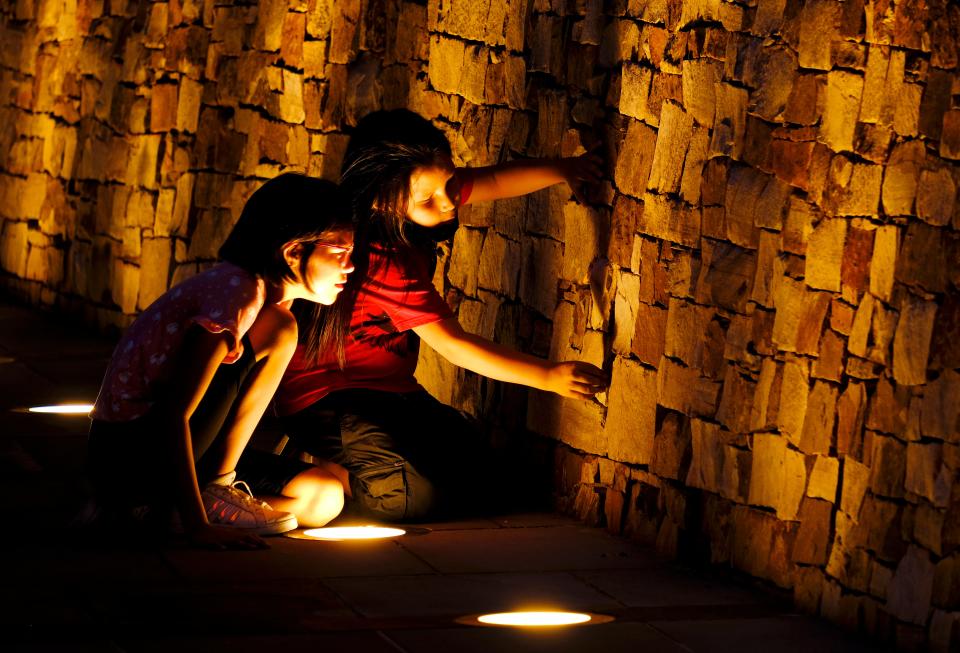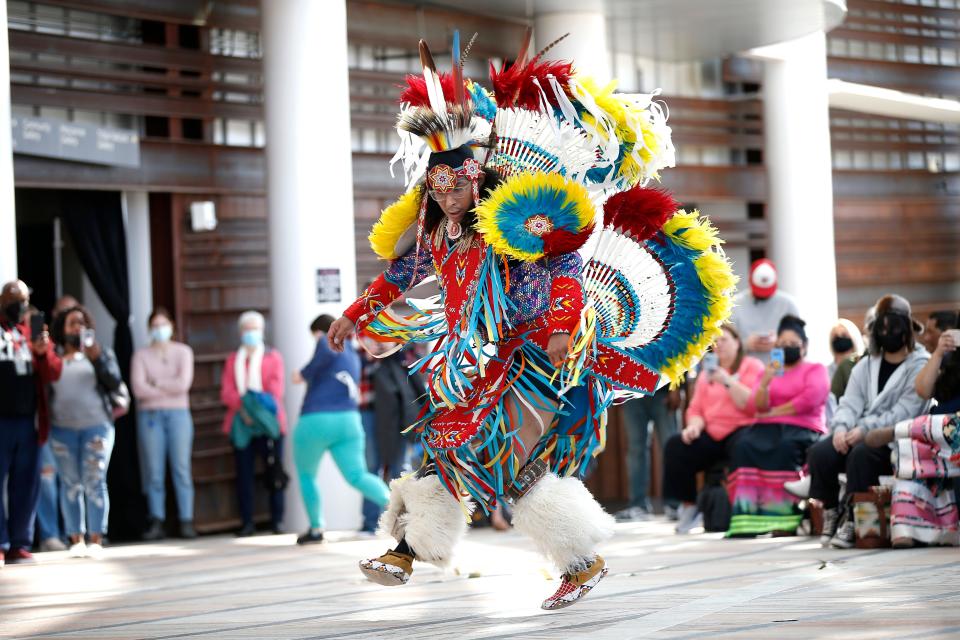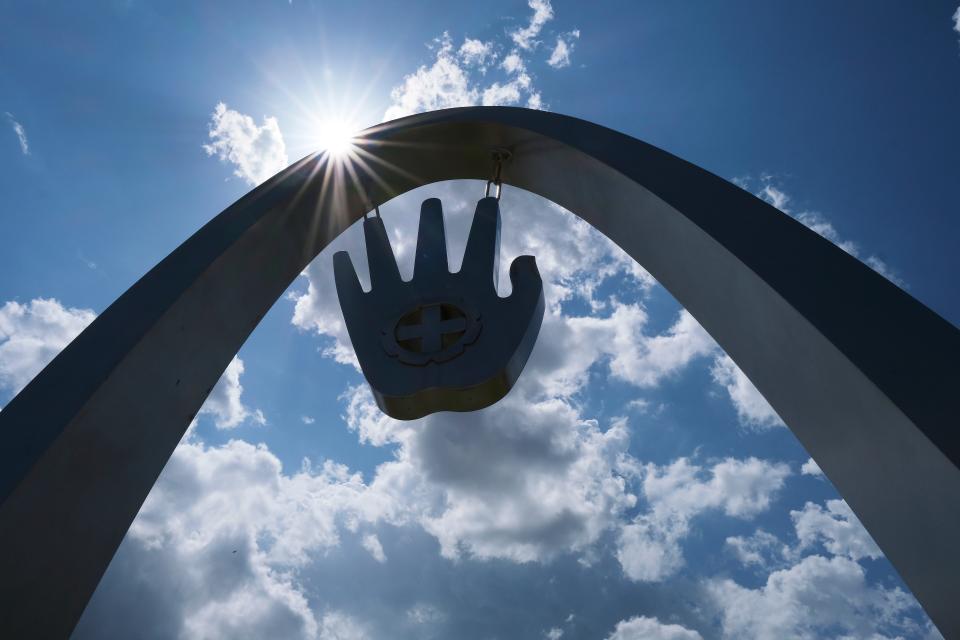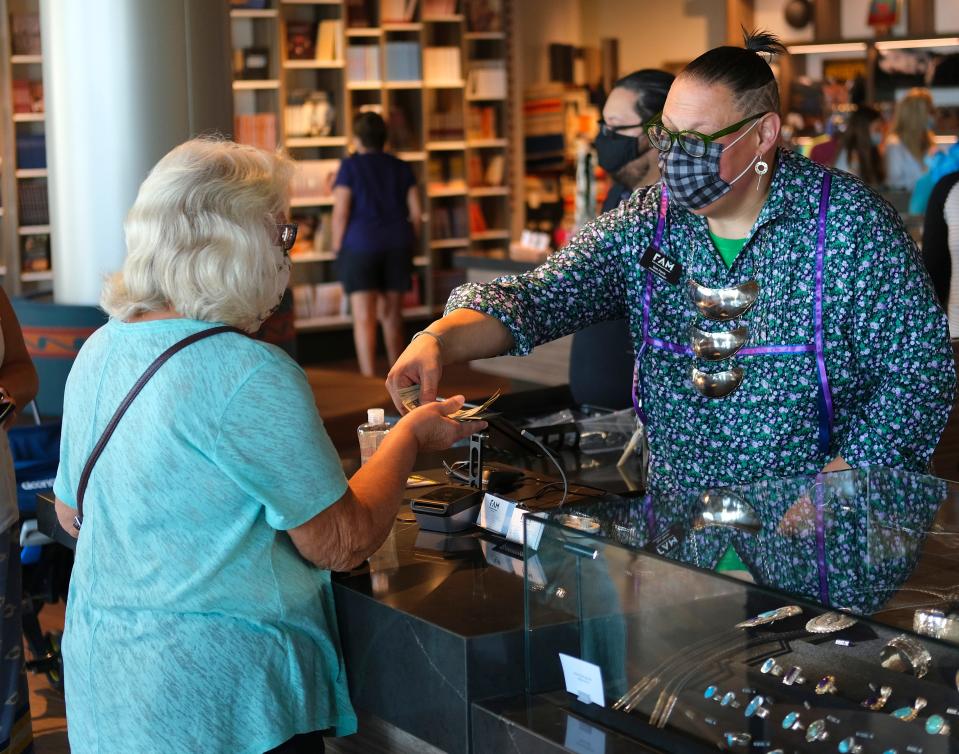First Americans Museum celebrates first anniversary with big attendance and bigger plans
More than 130,000 people have visited the First Americans Museum almost a year after the long-awaited landmark opened near downtown Oklahoma City.
"We've had visitors from every state — all 50 states — and then visitors from 26 different countries," said museum Director and CEO James Pepper Henry, a member of the Kaw Nation.
"That puts us probably in the top five of museums ... in Oklahoma for visitation, so that's pretty good. And that's including all the construction that's going on around us."
After more than three decades of planning, delays and construction, the First Americans Museum opened to the public Sept. 18, 2021, with hundreds of visitors, dignitaries and cultural ambassadors, including representatives from all 39 Native American tribes based in Oklahoma, taking part in the multi-day grand opening.

"FAM has been an amazing addition to the city, and it's already one of the top places I always tell visitors they have to go (to). That's because it's world-class and it's unique," Oklahoma City Mayor David Holt, who is Osage, told The Oklahoman.
"And the most exciting thing is that the experience will only continue to grow."
Between the museum's own expansion plans and work already underway nearby on the Chickasaw Nation's more than $300 million OKANA resort and waterpark, the future seems bright for the shining glass-and-steel landmark that once seemed unlikely to ever open.

How is the First Americans Museum marking its first year?
The First Americans Museum is celebrating its first anniversary Friday by hosting the inaugural Tribal Nations Gala. The sold-out soiree will be followed by an after party featuring live DJs, dancing and food and drink from the museum's acclaimed Thirty Nine Restaurant.
Along with raising funds for the nonprofit museum, the gala will honor several influential Native Americans: The late Enoch Kelly Haney, a former state senator and Seminole Nation chief who died in April, will be honored with the Lifetime Achievement Award; Chickasaw Nation Gov. Bill Anoatubby will receive the Distinguished Service Award; and Benjamin Harjo Jr., who is Seminole and Absentee Shawnee, will garner the Special Award for Artistic Leadership.
Cherokee artist Joseph Erb and Caddo potter Jereldine "Jeri" Redcorn, designers of two large-scale works inside the museum, will each receive the Creative Native Award.
"There's the Grammys, and then there's the Nammys. People are already calling … the awards that we're giving out the Fammys. So, it's already kind of taken on its own character," Pepper Henry said with a chuckle.
Also on Friday, the museum will open its new exhibition "First Americans Museum: Recent Acquisitions" in its Community Gallery. The exhibit will focus on artworks donated by former federal judge, lawmaker and Oklahoma City University president Robert Henry, who gifted his Native art collection to the museum.
"We got flooded at opening with a lot of gifts being offered; you can understand how overwhelming that was for us as just a small staff. … We've been working through how will we do accessions, using his collection as a point of discussion for our committee — and it's been a great opportunity," said Director of Curatorial Affairs Heather Ahtone, who is Choctaw and Chickasaw.
"We're working on being able to figure out how we can share some of these amazing works with people. But we have in this first body of work all of the heavy Oklahoma hitters: Acee Blue Eagle, Mars Biggoose, T.C. Cannon, Alan Houser and N. Scott Momaday."

What has been the response to the new First Americans Museum?
In honor of the one-year anniversary and the autumnal equinox, the museum and Oklahoma Arts Council will dedicate at 8 a.m. Wednesday four newly installed artworks in the FAM courtyard. Titled “Earth, Fire, Wind, and Water,” the ceramic pieces were made by father-and-son Cherokee artists Bill Glass Jr. and Demos Glass, who also created the museum's signature outdoor sculpture "Touch to Above."
"There's lots of things that are continuing to come to completion. … But I think people are, quite frankly, blown away with the depth of content and the depth of the experience," said Deputy Director Shoshana Wasserman, a member of the Thlopthlocco Tribal Town and Muscogee Nation.
"For tribal members, they hear the voices of people they know, they see photos of people they know, so there's this very connected experience that they're having that is so moving. Because everything is in first-person voice, our Native communities have walked out very empowered and very grateful that, finally, they feel like their perspective of history has been added to the greater dialogue."
On Oct. 1, Wasserman will mark 17 years since she joined the museum project. She said the outcome has been worth the wait.
Conceived in the 1990s as the American Indian Cultural Center and Museum, the $175 million, 175,000-square-foot First Americans Museum had its ground blessing ceremony in 2005, only to face years of uncertainty and delays.
Almost 40 years after it was initially envisioned, what originated as a project of the state of Oklahoma was completed through a partnership between the state and the city of Oklahoma City, with help of a Chickasaw Nation subsidiary, the American Indian Cultural Center Foundation and numerous donors.
Along with winning more than a dozen state, regional and national awards, the museum has hosted guests ranging from Oscar winner Leonardo DiCaprio to students from 113 area schools representing 71 districts. The 130,000 first-year attendance number represents just ticketed visitors; it doesn't include people who attended free events or rented the facilities.
"It has just exceeded our wildest expectations," Wasserman said. "I don't think any of us could have even imagined all of the museum programming we have been able to accomplish and all of the traffic that we've had from every state and so many countries."

What's next for the First Americans Museum?
Starting in October, the National Native American Hall of Fame will start using the First Americans Museum's welcome center.
"They're going to move from Montana to Oklahoma City. They're helping us raise funds to add an extension onto the museum to include the National Native American Hall of Fame as well as a few more changing exhibition spaces," Pepper Henry said. "So, that's in the works right now, and hopefully, in the next three or four years, we'll have that extension built."
Another major project for the First Americans Museum is completing its family discovery center, a key component that was delayed by the COVID-19 pandemic.
"We spent two years designing it. … It will be much more hands-on, experiential, and it will really foster interaction between the grandma who's 103 and the 3-year-old that's coming here," Wasserman said.
"We have $1.2 million worth of infrastructure already built into this space, but we have to raise about $8 million in funds. We don't know the exact number because when we did the last pricing was right before the pandemic. … That is our next priority (and) focus is finishing that."
Once the museum completes the fundraising, she said it will take about a year to build the family discovery center.
"As the Chickasaw Nation development comes online — their hotel and resort with the indoor-outdoor waterpark that they're hoping to have done at the end of summer 2024 — we hope that we can open this right about that same time," Wasserman said.

What's planned for the OKANA resort adjacent to the museum?
Work is already underway adjacent to the museum on the $342.1 million OKANA resort, which will feature an 11-story, 400-room hotel, a conference center, waterpark, outdoor recreational lagoon and entertainment center, along with dining and retail space.
It is expected to open in 2024, with a second phase that could include an aquarium.
"Marking the first year of the First Americans Museum offers time to reflect on the challenges First Americans have faced throughout our history. Family ties, commitment to community and dedication to a brighter future for our children and grandchildren have enabled First Americans to persevere," Chickasaw Gov. Anoatubby told The Oklahoman in an email.
Since its team has no intention of losing momentum now, the First Americans Museum will stay open during the OKANA construction.
"One of the other big activities that we're planning that we'll work with the development out here on is to have a major Native American or Indian art market similar to what is in Santa Fe … and having 600 to 700 artists featured here over a two- or three-day weekend," Pepper Henry said.
"We're not just a flyover state or a drive-by state … and we do have some really big plans for what's going to happen here — and to put Oklahoma on the map and Oklahoma City on the map for a lot of folks."
Features Writer Brandy "BAM" McDonnell has covered Oklahoma's arts, entertainment and cultural sectors for The Oklahoman for 20 years. Reach her at [email protected], www.facebook.com/brandybammcdonnell and twitter.com/BAMOK. Support her work by signing up for her See & Do Oklahoma newsletter and subscribing to The Oklahoman.
This article originally appeared on Oklahoman: One year after opening, OKC's First Americans Museum has big plans
